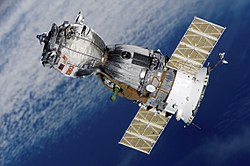 The launch of Soyuz MS-05 | |
| Mission type | ISS crew transport |
|---|---|
| Operator | Roscosmos |
| COSPAR ID | 2017-043A |
| SATCAT no. | 42898 |
| Mission duration | 139 days 4 hours 57 minutes 16 seconds |
| Spacecraft properties | |
| Spacecraft | Soyuz MS |
| Spacecraft type | Soyuz MS 11F732A48 |
| Manufacturer | Energia |
| Launch mass | 7080 kg |
| Crew | |
| Crew size | 3 |
| Members | Sergey Ryazansky Paolo Nespoli Randolph Bresnik |
| Callsign | Borei (Boreas) |
| Start of mission | |
| Launch date | 28 July 2017, 15:41 UTC [1] |
| Rocket | Soyuz-FG |
| Launch site | Baikonur, Pad 1/5 |
| Contractor | RKTs Progress |
| End of mission | |
| Landing date | 14 December 2017, 08:38 UTC [2] |
| Landing site | Steppes of the Kazakhstan |
| Orbital parameters | |
| Reference system | Geocentric orbit |
| Regime | Low Earth orbit |
| Inclination | 51.66° |
| Docking with ISS | |
| Docking port | Rassvet nadir |
| Docking date | 28 July 2017, 21:54 UTC [1] |
| Undocking date | 14 December 2017, 05:14 UTC [3] |
| Time docked | 138 days 7 hours 20 minutes |
 Mission insignia  From left to right: Nespoli, Ryazansky, Bresnik | |
Soyuz MS-05 was a Soyuz spaceflight which launched on 28 July 2017. [1] It transported three members of the Expedition 52 crew to the International Space Station. Soyuz MS-05 was the 134th flight of a Soyuz spacecraft. The crew consisted of a Russian commander, and a European and an American flight engineer. It returned to Earth on 14 December 2017 after 139 days on orbit.


